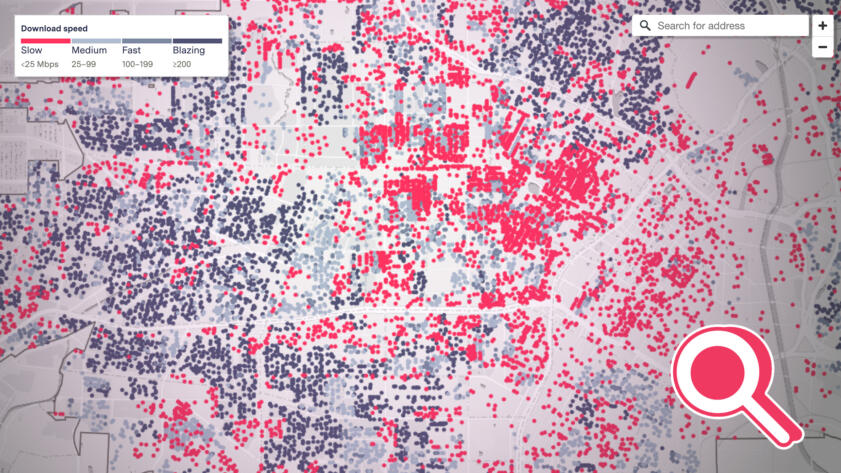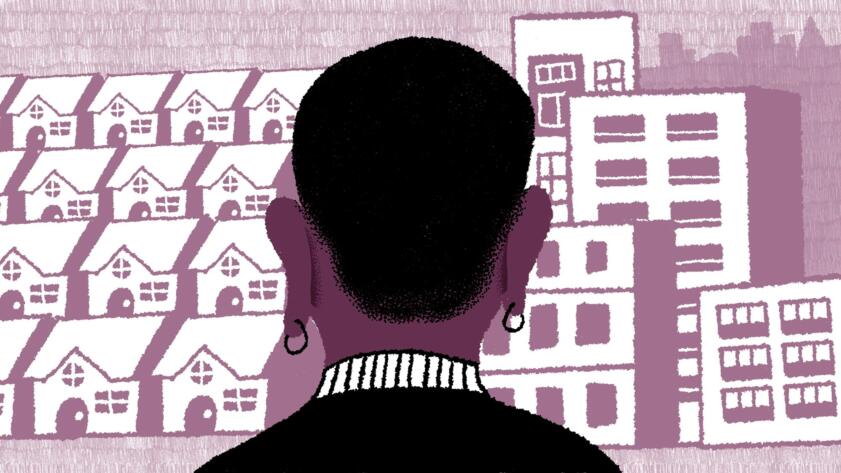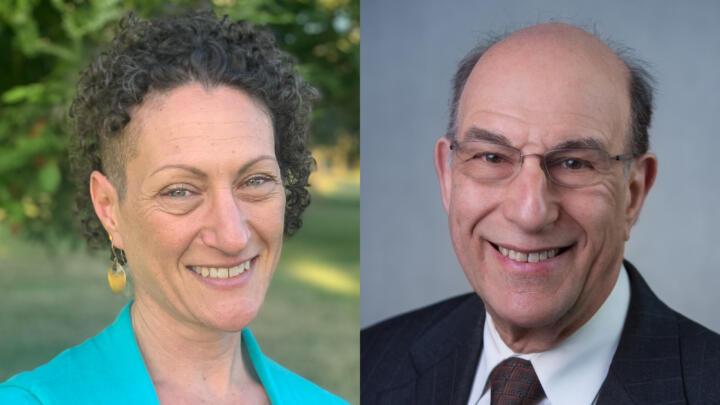Subscribe to Hello World
Hello World is a weekly newsletter—delivered every Saturday morning—that goes deep into our original reporting and the questions we put to big thinkers in the field. Browse the archive here.
Hi, I’m Aaron Sankin, and I’m a reporter here at The Markup. My beat is nominally the intersection of technology and inequality, but I’ve come to the conclusion that I’m actually a real estate reporter.
A couple of years ago, I published an investigation into a piece of predictive policing software called PredPol. We (and our publishing partners at Gizmodo) analyzed over five million PredPol predictions to determine which neighborhoods were targeted most frequently by the software. When it was published, the story got a nod in a newsletter called Today in Tabs, which said “PredPol is a company that uses advanced machine learning algorithms to tell police departments where Black people live.”

Prediction: Bias
Crime Prediction Software Promised to Be Free of Biases. New Data Shows It Perpetuates Them
Millions of crime predictions left on an unsecured server show PredPol mostly avoided Whiter neighborhoods, targeted Black and Latino neighborhoods
I steal this joke about 75 percent of the time I talk about the story (because it’s a good line), but something about it has stuck with me. This algorithm, which supposedly tells cops where crime is most likely to strike, can only disproportionately target Black neighborhoods because there are Black neighborhoods in the first place. The premise of this investigation, and the inequality it uncovered, rests on the bedrock reality that America is defined by widespread residential housing segregation along racial lines almost everywhere you look.
It’s not just crime prediction algorithms that disproportionately target where Black people live. An investigation I published last year showed these neighborhoods tended to get the worst deals for internet services. And when I looked at a shady auto insurance pricing scheme proposed by insurance giant Allstate, I discovered the people most likely to be harmed lived disproportionately in non-White areas.
Over and over, I keep backing my way into the same story: the places where marginalized people in America live repeatedly get the short end of the stick when it comes to, well, basically everything that can be distributed geographically.
All of this is why when I first discovered Richard Rothstein’s book “The Color of Law: A Forgotten History of How Our Government Segregated America” last year, I absolutely could not shut up about it. The book makes a provocative argument—one that, once you accept it, functions like a codex slotting so much of American history into place.
Residential housing segregation, Rothstein argues, didn’t just happen. It wasn’t the result of the individual prejudices of millions of people aligning so they just so happened to live next to people who looked like them. Instead, the creation of neighborhoods, defined primarily by White people not living there, was the result of specific, deliberate policies of the United States government. For example, the federal government subsidized both the construction of White-only subdivisions and the mortgages of the White families that moved into them, creating the financial engine that’s driven the American middle class for generations, while largely excluding Black families from the same opportunities.
In a new book, “Just Action: How to Challenge Segregation Enacted Under the Color of Law,” Rothstein and his daughter Leah, a community organizer and housing policy consultant, insist that all of us need to be responsible for ending it. The book is partly a history of how institutions like government agencies and real estate developers enforced and profited from segregation. And it is partly a how-to guide for everyday folks looking to make a real difference.
I spoke with Richard and Leah Rothstein about their book and the small steps necessary to fix the problem that seems to be at the heart of everything. This interview has been edited for length and clarity.
Sankin: How did you first get interested in the topic of housing segregation?
Richard: I was an education policy writer, covering public education primarily. I was, for a while, the national education columnist at The New York Times, writing a weekly column on education policy. I came to the conclusion that the most serious problem facing American public education was the concentration of the most disadvantaged young people in schools that became overwhelmed with the social and economic problems of their students.
Schools are segregated because the neighborhoods in which they are located are segregated.
I remember I wrote one column about asthma. African American children, as you probably know, have asthma at four times the rate, in some places, as White children because they live in more polluted neighborhoods—more diesel trucks driving by their homes, more dilapidated buildings, more vermin in the environment. If a child has asthma, that child is more likely to be up at night wheezing and then coming to school drowsy the next day. On average, a drowsy child is not going to achieve as well as a well-rested child. It makes a tiny difference, but then you add up all the disadvantages that children who are in low-income segregated neighborhoods come to school with—asthma, lead poisoning, homelessness, economic insecurity—you begin to explain the achievement gap.
I began to consider segregated schools to be the most serious problem facing American public education. And schools are segregated because the neighborhoods in which they are located are segregated. Neighborhoods are more segregated today than they have been at any time in the past 50 years.
That’s how I came to this topic. I began to look into how the neighborhoods came to be segregated.
In 2007, I read a Supreme Court decision that prohibited the school districts in Louisville, Ky., and Seattle from desegregating their schools in a very trivial way: If there was competition for the last remaining place in a school, the choice would be given to the child who would help desegregate the school. It was a trivial program; you don’t have one place left very often in a school and have both a Black and a White child apply for it.
But the Supreme Court denounced it. And it denounced it on the basis that the neighborhoods in Louisville and Seattle where these schools are located were segregated de facto: just by private prejudice. Discriminatory actions by businesses, people’s self-choice.

Still Loading
See the Neighborhoods Internet Providers Excluded from Fast Internet
Explore The Markup’s interactive map to see where AT&T, CenturyLink, and Verizon offered only slow internet speeds in major U.S. cities
A White homeowner in a single-family home in an all-White suburb of Louisville had an African American friend in the center of the city, a decorated Navy veteran with a wife and child. [He] wanted to move to a single-family home, but nobody would sell him one. The White homeowner bought a second home in the suburb and resold it to his African American friend. When the African American family moved in, an angry mob surrounded the home protected by the police. They dynamited the home, they firebombed it. And when the riot was all over, the White homeowner was arrested, tried, convicted, and jailed for 15 years for sedition. For having sold a home to a Black family.
I said to myself, this doesn’t sound to me like de facto segregation. I began to look into it further, and that’s how I came to write “The Color of Law.” In Louisville, the police are agents of the state government. This wasn’t de facto segregation; it was a blatant violation of the 14th Amendment for the police to be organizing and protecting that mob. This happened in hundreds of places. And there were many other policies of the federal, state, and local government that were equally racially explicitly designed to ensure segregation.
Sankin: The idea that segregation is the result of individual decisions stemming from individual prejudices of average, everyday folks—how did that mythology develop?
We have a responsibility to remedy it. Our government took unconstitutional actions, and therefore the government and we—as citizens and residents—have an obligation to do something about it.
Leah: This notion that it’s personal choice, that we like to live around people who look like us, that it happened by accident—when we believe that, we don’t believe there is anything we can do about it. We don’t believe we have a responsibility to do anything about it. Something that happens by accident can only un-happen by accident.
But if we really start to accept and understand the history, the true history like what’s outlined in “The Color of Law”—that it was intentional action by all levels of government and private actors who were incentivized or required by the government to create segregated communities—then we see we have a responsibility to remedy it. Our government took unconstitutional actions, and therefore the government and we—as citizens and residents—have an obligation to do something about it.
Sankin: One of the things that you wrote about in the book is how there were these financial institutions and home builders that refused to sell to African Americans.
Many of these institutions still exist today, in some form or another, and you make the argument that these institutions have a special responsibility to rectify these problems that they either caused or sat back and benefited from. Can you talk about the specific actors that benefit from this and now have a responsibility to try to rectify it?
Richard: In Charlottesville, we talk about one particular community where a restrictive racial covenant identified the bank and the real estate agency and the developer that cooperated with the federal government, which was subsidizing the development, that created this segregated community for White people only. The bank was absorbed by a larger bank; it’s now the Virginia National Bank. The real estate company was absorbed by a larger real estate company, Howard Hanna real estate, a prominent national real estate firm. And the developer is still in existence today. It used to be named for Robert E. Lee. After the Black Lives Matter demonstrations, they changed their name just to Lee Building Company.
Each of those three institutions still exists today. Those successors not only absorbed the financial liabilities of the real estate agency and the banks that they absorbed, respectively, but the moral responsibilities as well.
Sankin: What sorts of policies do you see being necessary in opening up, literally or metaphorically, gated communities to a wider set of folks?
Leah: One strategy that some communities and a few states have already adopted, and which several others are considering, is changing zoning law. That is a locally controlled policy. Often, these exclusive communities are zoned only to allow for single-family homes to be built in them. It’s called exclusionary zoning. It took the place of race-based zoning when that was outlawed. By ensuring these communities only allow single-family homes, often on large lots, it limits the amount of housing that can be built in that community. It ensures that the only housing there will be expensive—unaffordable to low-income families and moderate-income families that don’t have intergenerational wealth to pay for a down payment.
White people were subsidized into home ownership when it was affordable and African Americans were prohibited from doing so.
That’s more often African Americans than White people for all of the reasons we’ve been talking about. White people were subsidized into home ownership when it was affordable and African Americans were prohibited from doing so. We can change the zoning in those communities to allow for a diversity of housing types—to allow duplexes, triplexes, small, multifamily buildings on the same lots that now only allow single-family homes.
That can begin to create more supply of housing, more affordable units because they’re smaller, and to allow for a wider range of affordability options as the first step toward diversifying those communities.
Sankin: Let’s say I’m a person who first got engaged by the Black Lives Matter protests. I went out and marched. I want to be able to do something more, but don’t know what to do in my local community. What is something a person in that situation can do that could really make a difference?
Leah: A couple of examples are a community could start or support a land trust. A land trust creates affordable home ownership opportunities in communities where prices are rising or gentrifying. In suburban, expensive communities, they can create long-term, affordable home ownership opportunities for low- or moderate-income households and prevent displacement in gentrifying communities. That’s one example.
A local group could start a down-payment assistance program to provide down-payment assistance to African American homebuyers, who lack the intergenerational wealth that White people more often have to buy homes because of the past policies that subsidized White people to get into homeownership and prohibited African Americans.
They can advocate locally to change zoning ordinances to allow duplexes and triplexes and increase the affordability of homes in that area.
Sankin: How should folks who are pushing for these policies, especially around zoning, deal with pushback?
Leah: We talk about the prevalence of NIMBY (Not In My Backyard) activists, who try to block building affordable housing or multifamily housing in exclusive communities. They argue that it will forever change the character of the community, that it will increase traffic and increase crime—all of these thinly-veiled racial comments about the devastation that will happen to a community if they start to diversify.
I think NIMBYs have had a good run of blocking a lot of development. Now, as we build a movement that can redress segregation and challenge these laws, local activists will need to be as vocal and as strong as NIMBYs have been in blocking them. It’s possible. We have examples in our book and in a Substack column that we’re writing of communities that have countered this NIMBY opposition.
I think what helps is really breaking down their argument. They think it’s about community character. They think this is a community that they are entitled to live in, [where they are] entitled to forever increasing property values. When we look at the history and see how the communities were created, [they were] intentionally created to benefit the White families who are allowed to buy into them and to exclude African American families.
Sankin: What do you think of the nascent YIMBY (Yes, In My Backyard) movement?
Richard: It’s a step in the right direction. There’s a lot of potential in these communities for people to mobilize and support greater density and more housing opportunities. The YIMBYs typically are young professionals who can’t afford to live in the type of communities where they grew up. These are middle-class people. And if they support, and they are supporting, the upzoning efforts, they can add their weight to the political force to make it happen.
Neither White people nor Black people can afford to buy housing unless they had wealth inherited from parents and grandparents.
But the YIMBYs themselves are not typically the middle-income African Americans who have been excluded from these communities. Because we have such an enormous housing shortage, neither White people nor Black people can afford to buy housing unless they had wealth inherited from parents and grandparents, as a result of their benefit from federal programs that excluded African Americans.
It’s an important thing for YIMBYs and their allies to get upzoning rules adopted. But more affirmative steps—affirmative action in housing—need to be taken to ensure that African Americans benefit from those programs, because otherwise they’ll be outbid by the YIMBYs and other wealthier White people.
Sankin: It seems like the first step to all of this is to change the way that people see their social environment—opening people’s eyes to it not just being happenstance that these people live over here, and those people live over there.
Has writing and researching this book changed the way that you move through your own built environment? Has it changed the things that you’ve noticed when you go through a new city?
Leah: I would say that through the research for this book and going around the country speaking about it, what has shifted for me is just how many people out there are wanting to do something about this. Black and White, urban and suburban, lower-income and higher-income communities. That has been very heartening and inspiring and hopeful for me.
I started this project with my dad hoping to feel hopeful about what we can do about segregation. I wasn’t sure, because I’ve heard so many of the stories about NIMBYs blocking progress on these issues. There’s an overwhelming nature to it. I’ve been an organizer in my past career and also worked in housing policy—it’s often fighting an uphill battle. It’s difficult.
What I have gotten out of this is just seeing how hopeful it is. Seeing how, in every type of community we’ve visited, there are people there wanting to see change, working on change, and implementing strategies that are having some success. That’s how my outlook has changed based on this work.
Thanks for reading,
Aaron Sankin
Investigative (Real Estate?) Reporter
The Markup





